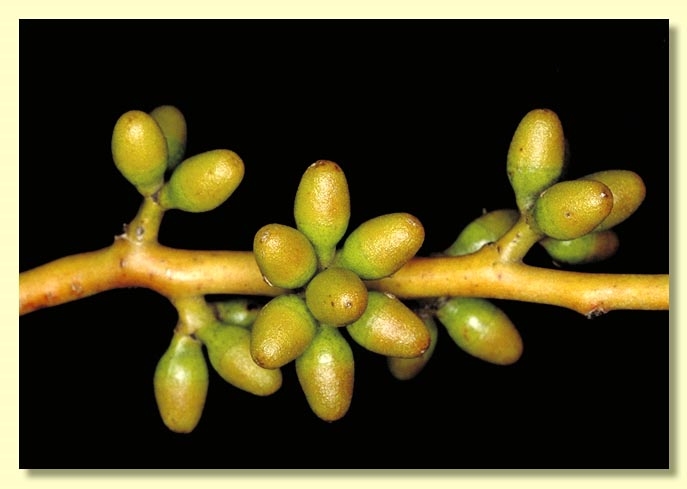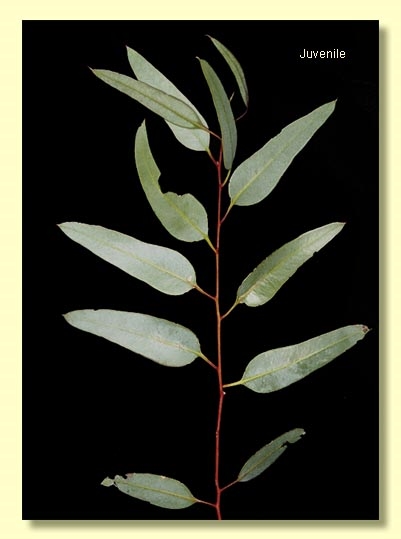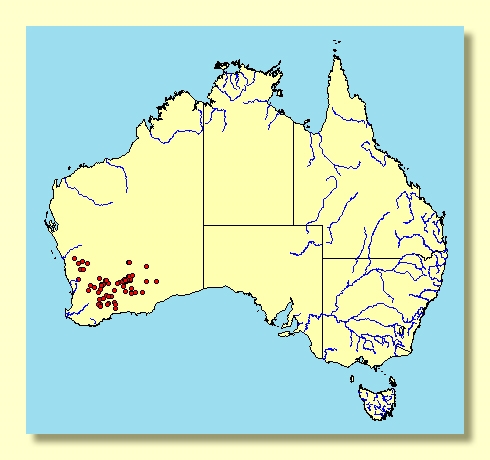Euclid - Online edition
Eucalyptus salubris
Eucalyptus | Symphyomyrtus | Bisectae | Glandulosae | Contortae
Bark smooth throughout, shiny, steely grey or olive green to tan, coppery or yellow.
Branchlets non-glaucous; oil glands present in the pith.
Juvenile growth (coppice or field seedlings to 50 cm) stems rounded in cross-section, non-glaucous, the very base will have started to develop typical adult bark; juvenile leaves always petiolate, opposite for up to 5 nodes then alternate, lanceolate, 6.5–9.5 cm long, 2–3 cm wide, dull, grey-green or slightly glaucous, weathering green, glossy.
Adult leaves alternate, petioles 0.7–2 cm long; blade lanceolate to narrowly so, 6.5–10.5 cm long, 0.7–1.5 cm wide, base tapering to petiole, margin entire, apex pointed, concolorous, glossy, green, side-veins at an acute or wider angle to midrib, reticulation sparse to moderate, intramarginal vein more or less remote from margin, oil glands irregular in outline, island.
Inflorescence axillary unbranched, peduncles stout, broadened apically, 0.4–2 cm long, buds 7, pedicellate (pedicels 0.1–0.7 cm long). Mature buds ovoid to broadly fusiform (0.6–1.2 cm long, 0.3–0.7 cm wide), scar present, operculum obtusely conical, all stamens inflexed but to varying degrees, anthers narrowly oblong, versatile, sub-basifixed, dehiscing by longitudinal slits, style long and straight, stigma blunt, locules 3, the placentae each with (5)6 vertical rows of ovules. Flowers white.
Fruit normally pedicellate (pedicels (0)0.1–0.6 cm long), obconical to hemispherical, 0.3–0.6 cm long, 0.5–0.7 cm wide, disc level to descending, valves 3, exserted.
Seeds pale to dark brown, 1–2 mm long, ovoid or flattened-ovoid sometimes polygonal in outline, dorsal surface deeply, narrowly and closely fissured, margin ragged, hilum ventral. (Seedcoat often referred to as being honey-combed.)
Cultivated seedlings (measured at ca node 10): cotyledons Y-shaped (bisected); stems square in cross-section, smooth or slightly warty; leaves always petiolate, opposite for ca 5 nodes then alternate, lanceolate, 7.5–10.5 cm long, 1.5–3 cm wide, dull, grey-green.
Flowering has been recorded in February, March, August, September, November and December.
A small mallet, endemic to Western Australia. It is very widespread in the wheatbelt and Goldfields from Mullewa in the north-west, south-east to near Pingrup and Mt Short near Ravensthorpe, extending east and north to Norseman and Zanthus and Lake Minigwal in the western part of the Great Victoria Desert and north to Admiral Flat near Laverton. The bark is smooth, brilliant coppery in season. The adult leaves are very glossy, green. Buds are in sevens on prominently flattened peduncles.
Eucalyptus salubris belongs in Eucalyptus subgenus Symphyomyrtus section Bisectae subsection Glandulosae because the buds have two opercula, the cotyledons are bisected and the branchlets have numerous oil glands in the pith. Within this subsection E. salubris belongs to a well known small group, the gimlets (series Contortae), a group notable for the slender fluted, twisted shiny colourful trunks. The gimlets are further recognised by very irregular island oil glands in the leaves and irregularly and deeply pitted seed-coats.
E. salubris is one of six true gimlet species with buds in sevens; the others are E. campaspe, E. effusa, E. ravida, E. terebra and E. tortilis. The mallee species E. effusa is a slightly atypical gimlet in having scruffy-ribbony lower stems. The non-glaucous E. salubris is easily distinguished from E. ravida and E. campaspe, both of which have conspicuously glaucous branchlets. E. terebra has larger, sessile, crowded buds and fruit (pedicellate in E. salubris). E. tortilis is morphologically closest to E. salubris differing only in having larger buds with more acute operculum and slightly larger fruit. Two other gimlet species, E. creta and E. diptera, have buds in clusters of 3 and are generally smaller trees than E. salubris.














